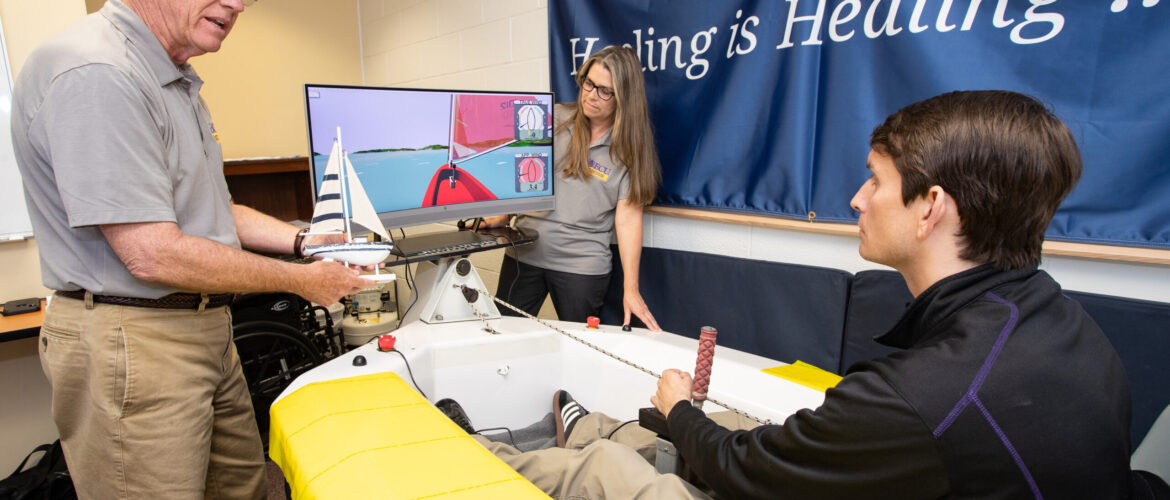Cari E. Autry, Ph.D., LRT/CTRS
Stephen C. Anderson, Ph.D.
Department of Recreation Sciences
East Carolina University
Greenville, North Carolina, USA
East Carolina University houses a Simulation Lab in the Department of Recreation Sciences. The purpose of the lab is to use virtual reality sailing simulators (VRSS) as an intervention for people with disabilities to increase their quality of life physically, emotionally, cognitively, and socially and to produce evidence through research in the field of recreational therapy. One of the Simulation Lab’s research projects, led by Dr. Cari Autry and Dr. Stephen Anderson, focuses on virtual reality sailing simulation (VRSS) and quality of life for people with physical disabilities, based on the hypothesis that participation in the VRSS program will result in an increase in participants’ simulator sailing standard scores – knowledge (cognitive) and skills (physical) – which is the competence level required for sailing on the water, and an increase in their quality of life (QOL) scores. While the research is still ongoing, all six participants with physical disabilities who have completed the research protocol acknowledged that the VRSS Program contributed to their quality of life and impacted their lives in some way within all four domain areas (physically, cognitively, emotionally, and socially).
Sailing is pursued for both leisure and competitive sport purposes. Participation in sailing is regarded as having positive outcomes on people’s quality of life (Recio et al., 2013). The same outcomes apply to people with disabilities; however, evidence-based research on the therapeutic use of sailing is limited (Autry & Anderson, 2016). Low participation rates of people with disabilities in sailing programs is one reason for this lack of research. Common constraints to sailing include: knowledge and skill of sailing, access to sailboats, swimming skills, financial resources, and the perception that sailing is elitist and dangerous (Recio et al., 2013). These constraints are exaggerated for people with disabilities and, as such, they typically do not choose sailing as a leisure activity or a sport.
Virtual reality sailing simulators (VRSS) have the potential to bridge the gap between sailing on land and sailing on the water for people with disabilities (Recio et al., 2013; Saunders et al., n.d.; Virtual Sailing, n.d.). East Carolina University houses a Simulation Lab in the Department of Recreation Sciences. The purpose of the lab is to use VRSS as an intervention for people with disabilities to increase their quality of life physically, emotionally, cognitively, and socially and to produce evidence through research in the field of recreational therapy. The lab is also a member of a VRSS International Research Consortium comprising of 8 countries and includes 25 members and 7 universities/research institutes.
One of the Simulation Lab’s research projects focuses on virtual reality sailing simulation (VRSS) and quality of life for people with physical disabilities. The research hypothesis: participation in the VRSS program will result in an increase in participants’ simulator sailing standard scores – knowledge (cognitive) and skills (physical) – which is the competence level required for sailing on the water, and an increase in their quality of life (QOL) scores.
The study is ongoing; although, six participants with physical disabilities have completed the research protocol. Of those six, three have spinal cord injuries (1 quadriplegia, 2 paraplegia), one has cerebral palsy, and two have spina bifida. Five use a wheelchair full time and one uses crutches and a wheelchair. Four are females and two are males, with an age range of 27-50 years.
The virtual reality sailing simulator is an actual boat with a steering mechanism, mainsail sheet and a computer screen. The boat is on a frame, so it is able to tilt (heel) like a sailboat on the water. The screen allows for visual access to steering, sail trim, wind direction and gusts, boat speed, buoys, and geographical setting which includes a famous body of water with landmarks (see photo). For this research study, the VRSS boat and screen are modeled after an accessible sailboat, the Hansa Liberty and it is adapted with a seat and joystick (manual and electronic). The VRSS Program: Learning to Sail on Land consisted of 11 sessions, each 1.5 – 2 hours. An adaptive sailing program was followed, which included sailing knowledge and skills, e.g., steering, sail trimming, reading the wind, points of sail, sailing a race course, tacking and jibing, knot tying, and nautical terms. The sailing instructor is certified with the US Sailing Association. One researcher is licensed and certified as a recreational therapist and both researchers are professors of recreational therapy.
For quantitative data analysis, the World Health Organization Quality of Life- BREF (WHOQOL-BREF) was administered pre and post program. The WHOQOL-BREF is a 26-item questionnaire, including four domains: physical health, psychological, social relationships and environment. A study prerequisite was that the participant could never have sailed before. A post study sailing standards instrument measured sailing knowledge and practical sailing skills. Physical sailing skills were measured by reach and strength tests. Balance was measured pre and post using the Functional Reach Test: Modified Functional Reach and strength was measured pre and post using the degree in movement of the manual joystick. Observations by the two researchers were used for formative evaluation and a check list was used during each session. The participants’ scores (WHOQOL-BREF, Sailing Standards, Reach, Strength) and session assessment data will be analyzed using SPSS software.
For qualitative data analysis, post interviews were conducted using an interview guide focusing on the following areas: Leisure, Quality of Life, VRSS Program, and Sailing on the Water. Observations were also made for formative evaluation and notes were kept each session. The qualitative data will be analyzed using NVivo software. Various coding methods will be applied including Attribute Coding, Provisional Coding, In Vivo Coding, and Eclectic Coding.
To date, the results show that all six participants who have completed the VRSS Program: Learning to Sail on Land have passed the sailing standards (knowledge and practical skills). All reported they felt comfortable and would like to progress to an on the water sailing program if it was available. All six acknowledged that the VRSS Program contributed to their quality of life and impacted their lives in some way within all four domain areas (physically, cognitively, emotionally, and socially). All six participants avowed that their perceptions about sailing changed after the VRSS Program. They never thought that someone with a physical disability would be able to sail as it relates to having access to an adapted sailboat, having the ability and skills to sail, and enjoying sailing. As an example, one participant reported, “Never did I think this adrenaline junkie would be excited about sailing or BE ABLE to adaptive sail! Thanks to two Drs. who teach recreational therapy at ECU, they have made it possible… never say never”.
As a follow-up to this research study, five of the six participants qualify to move on to a Phase II: Sailing on the Water (Adapted Sailing Program) using a Martin 16, a sailboat specifically designed and built to accommodate people with physical disabilities. It is very similar to the VRSS having a joystick, mainsail sheet, etc. and it has an instructor’s seat located behind the participant’s seat. One of the six participants will not qualify at this time due to a need for electronic adaptions which the VRSS has but is currently not available in the Martin 16. The Phase II research study will follow a 6-session adaptive sailing program. The same dependent variables, as in Phase I, will be tested pre and post program. An additional variable of connectedness to nature (Mayer & Frantz, 2004) will be used to examine how sailing as a nature-based activity could add to quality of life. Perceptions about and constraints in accessing nature for the participants with physical disabilities will also be explored. Phase II results will be compared with Phase I results.
References
Autry, C., & Anderson, S. (2016). Therapeutic use of sailing. In J. Dattilo & A. McKenney (Eds.), Facilitation techniques in therapeutic recreation. College State, PA: Venture Publishing, Inc.
Mayer, F. S., & Frantz, C. M. (2004). The Connectedness to Nature Scale: A Measure of Individuals’ Feeling in Community with Nature. Journal of Environmental Psychology,24, 504-515.
Recio, A., Becker, D., Morgan, M., Saunders, N., Schramm, L., & McDonald, J. (2013). Use of a virtual reality physical ride-on sailing simulator as a rehabilitation tool for recreational sports and community reintegration: A pilot study. American Journal of Physical Medicine & Rehabilitation, 92(12), 1104-1109.
Saunders, N. R., Binns, J. R., Recio, A. C., & Habgood, M. D. (n.d.) Physical ride-on sailing simulators as a means for people with disabilities to learn to sail on water. Retrieved from http://www.virtualsailing.com.au/Publications/Saunders__Norman.original.1474595363%20copy.pdf
Virtual Sailing (n.d.) History: Sailing for people with disabilities. Retrieved from http://www.virtualsailing.com.au/history/
__________________________
Photo by Rhett Butler, East Carolina University, USA.





Leave a Comment